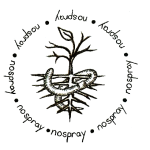Warning: Illegal string offset 'filter' in /var/www/wp-includes/taxonomy.php on line 1700
How to easily break apart Hawaii clay into healthy soil
[wowslider id=”91″]
The east side of the Hawaiian Islands is covered with red clay. Our No Spray Homestead is located on red clay and we work with it everyday. Hawaiian red clay can be quite frustrating in growing naturally and organically and without the use of sprays. Although a workable medium, red clay is just rusted dirt. The rust is high amounts of oxidized iron which creates the “red” color. Think of a rusting nail, it turns red, same with the soil. Clay can be useable and productive if given appropriate amendments.![IMG_4973[1]](https://nosprayhawaii.com//wp-content/uploads/2013/04/IMG_49731-300x224.jpg)
Ultimately you want your soil to be able to hold together when compressed, yet easily break apart when slightly tapped. Click to see SOIL TEST VIDEO. Also when considering the Six Main Components of Soil, (Minerals, Organic Matter, Oxygen, Water/Moisture, Life Above and Life Below), clay lacks most of the requirements to be considered soil. Clay though is still a great resource! We can add different materials to clay to create a great growing medium.
We can do this on large scale as well by sheet mulching, continual additions of compost and growing a variety of plants and animals. The healthy ecosystem that is created will be able to break apart further additions of compost into useable nutrients that can be delivered to the plant in any order, fashion and amount wanted by the plant. (READ MICROBES FOR FURTHER EXPLANATION)
Tilling red clay for planting a crop for natural and organic agriculture, although seemingly easy at the beginning usually harbors more harm than good to the natural, no spray, farmer. Mechanical tilling kills the very ecosystem that you are trying to create as a natural, no spray food grower. Initially it will work to grow a crop out with ample nutrients. This initial rise in nutrients is in actuality the ecosystem and all its life that you are trying to create, dying. Once this happens, if you plant a crop, you will have to supply it all its nutrients, all the time, making your life as a natural farmer, harder than that of a conventional farmer in dealing with diseases and outbreaks.
The ecosystem that can solve all your problems needs time to be created, on average three to five years once disturbed. It is a web that stretches on the top six inches of Hawaii’s soil. Once disrupted through tilling and heavy machinery like tractors, that web needs time to repair itself. At this point you would only want to plant disease-resistant, high mulch-producing, hardy plants in this area until the ecosystem recovers.
Clay has some minerals and ample moisture holding ability, but lacks organic matter, oxygen, life above, and life below. The ability to hold water is a great attribute of clay and is one reason why people consider it a great soil medium. So with this in mind we can add minerals, organic matter, room for oxygen and life merely by adding compost and compostable materials to the clay.
Here at No Spray Hawaii, we love composting! All organic and natural farmers should. Composting does so much for the soil and your plants, it would be silly gardening and not love compost! Healthy compost is a brown in color, crumbly and smells GOOD!
You can create good compost in so many different ways! Looking around your area is the best way to determine the best composting situation for you. Take the time to read a book on composting, it is a simple concept and if you read one book on the subject, you will feel as if you have read them all.
We have a steep driveway covered by large lychee trees. The leaves constantly drop on the road. If we left them, describing a realistic scenario of a healthy natural ecosystem, nature would break the leaves apart to create its own compost. Pigs would naturally walk over them at night breaking them apart. Driving up and down the driveway would also break the leaves down. Slugs would attach to the newly dropped leaves helping to further break them apart, digesting them and leaving their own castings. Other creatures and microbes would start to break the leaves down further. Earthworms would come next, eating what ever is left along with gravel and rocks eventually producing soil.
This is the perfect area for weeds to grow! Here at No Spray we like to prevent the urge to spray so we show you the No Spray Way! We try to prevent open, bare soil for weeds to grow. So sweeping the road prevents future soil buildup where weed seeds can sprout. But instead of sweeping all this soil producing material off to the side, or worse even, removing it from the property at all, we use it for creating our soil mix for potted plants.![IMG_4978[1]](https://nosprayhawaii.com//wp-content/uploads/2013/04/IMG_49781-300x224.jpg)
You could do the same with any excess brown material, droppings or excess organic matter. If you don’t have any material like this laying around- plant it! There are different plants that grow well in all types of soil. Find them, plant them and wait for their “excess leaves”. Use the leaves to begin a compost pile. Start small and grow! For a personal consultation please feel free to CONTACT NO SPRAY HAWAII.
And remember… No Spray, Find Another Way!
How to easily break apart Hawaii clay into healthy soil
============================================================
About the Author:
 Laura Rieber holds a BS in Agriculture with a focus on sustainability from the University of Hawaii, several certificates in agriculture business development and is a master gardener. The moment she realized the corporate lies that feed the world was the moment she was inspired to write about the truth about natural agriculture. She co-created No Spray Hawaii with her partner, Jesse Fujimoto to help others gain awareness. She teaches natural agriculture principles on the Big Island of Hawaii. CONTACT
Laura Rieber holds a BS in Agriculture with a focus on sustainability from the University of Hawaii, several certificates in agriculture business development and is a master gardener. The moment she realized the corporate lies that feed the world was the moment she was inspired to write about the truth about natural agriculture. She co-created No Spray Hawaii with her partner, Jesse Fujimoto to help others gain awareness. She teaches natural agriculture principles on the Big Island of Hawaii. CONTACT
==========================================================
References and GREAT books / articles to read:
Denice de Oliveira Almeida, Osmar Klauberg Filho, Henrique Cesar Almeida, Luciano, Gebler, Aline Franciane, Felipe. 2010 “Soil microbial biomass under mulch types in an integrated apple orchard from Southern Brazil”. Sci. Agric. (Piracicaba, Braz.), v.68, n.2, p.217-222, March/April 2011
Herms, Daniel A, Lloyd John E, and Stinner, Benjamin R. 1999. “Effects of Organic Mulches and Fertilization on Soil Microbial Activity, Nutrient Availability, and Growth of River Birch”. Department of Entomology, The Ohio State University, Ohio Agricultural Research and Development Center. Wooster, Ohio
Hoorman, James J, and Islam, Rafiq. 2010. “Understanding Soil Microbes and Nutrient Recyling”. Ohio State University, Extension
Jean M. A., Marshall Bradley, Nick & Fern, 1994. “Growing Fruits and Vegetables Organically”. Rodale Press
Gladstone, Nancy. 1997. “Action Sheet 34: Mulching, So what is mulching?” Outreach TVE Soils Education Pack:Soil Improvement in the Tropics article on Mulching.
Lownfels, Jeff & Lewis, Wayne. 2010. “Teaming with Microbes, The Organic Gardener’s Guide to the Soil Food Web”. Timber Press: Portland, Oregon.
Stewart Amy, 2004. “The Earth Moved, On the Remarkable Achievements of Earthworms”. Algonquin Books of Chapel Hill: North Carolina.
Find the other way!

